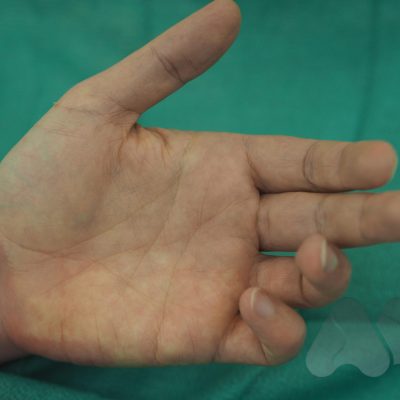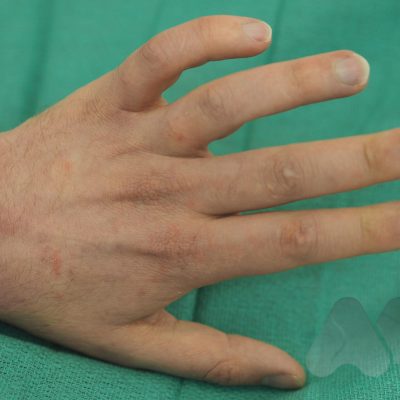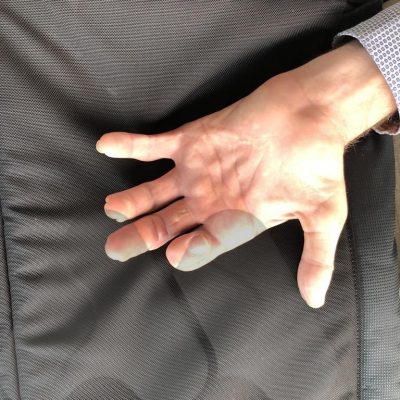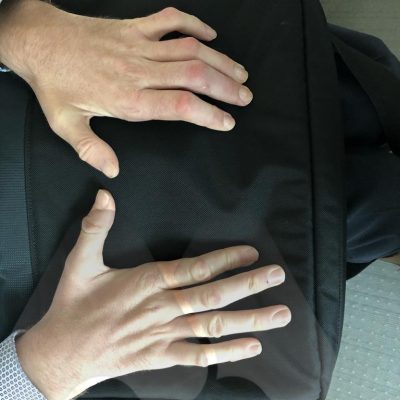What is it?
How do I know if I have cubital tunnel syndrome?
Symptoms can include numbness or tingling in the little and ring finger. Initially these symptoms can be intermittent when the elbow is bent for long periods of time such as using a hairdryer, on the phone or when leaning on the elbow.
Persistent numbness and weakness of the small muscles of the hand can occur in more severe cases, which can sometimes present itself as clumsiness of the hand or difficulty writing or handling coins, which develops progressively over weeks to months. You may notice some wasting of the muscles in the hand compared to the other side or a claw-like posture of the fingers where the ring and little fingers naturally rest in a more bent position.
In younger patients, a sensation of a painful flick of the nerve can signal the nerve is slipping out of it’s normal tunnel at the back of the elbow and can be accompanied by any of the other more common symptoms discussed above. This is termed ulnar nerve instability.
Nerve conduction studies can diagnose cubital tunnel syndrome if there is any doubts about the diagnosis or if you have multiple possible causes for your symptoms. An ultrasound is occasionally of benefit to assess nerve instability or nerve swelling. These additional tests are not always performed if the diagnosis is clear.
NOTE:
Sudden clumsiness in the hand is almost never caused by cubital tunnel syndrome or any other nerve entrapment problem and may warrant urgent investigation for conditions like Stroke or a TIA (mini-stroke).
What can I do to treat cubital tunnel syndrome?
Early intermittent symptoms can be treated by physiotherapy/hand therapy and changing postural habits:
- Neural glide exercises – help keep the nerve from getting scarred in it’s tight tunnel
- Avoid resting your elbows on hard surfaces like desks or arm rests and if this is unavoidable, try padding the surface.
- Avoid keeping your elbow bent for long periods of time.
- Use headphones or an earpiece when on the phone
- Wrap a towel around the elbow at night time to help break sleeping habits if you tend to sleep with your elbow bent
- Use headphones or an earpiece when on the phone
- Wrap a towel around the elbow at night time to help break sleeping habits if you tend to sleep with your elbow bent
If the numbness and tingling become a constant feature or you start to get weakness or clawing of the fingers then a referral to a hand surgeon to discuss surgical treatment is recommended.
What is a cubital tunnel release?
Surgery to release the cubital tunnel involves a small cut, about 4-6cm in length, behind the inner part of the elbow. Surgery is normally performed under a general anaesthetic but can also be done using wide awake surgery techniques in patients who do not want or unfit to have a general anaesthetic. You will usually be able to be discharged from hospital on the same day as your surgery.
The ligaments and muscles, that create the tunnel in which the ulnar nerve travels, are released to make more space for the nerve. The nerve is freed up along a longer length in the arm compared to the size of the incision. After surgery, don’t be alarmed if you develop some bruising and discomfort from the upper arm, down to the forearm, this is is to be expected. If the nerve is moving out of it’s normal position behind the elbow, it may be moved to a more stable position in front of the elbow and held in place with a sling of tissue. This procedure is called an ulnar nerve transposition and different types of transposition include:
- Subcutaneous (nerve sits under the skin)
- Sub-fascial (nerve sits in a sling of muscle covering on top of the muscle)
- Sub-muscular (nerve sits deeper within the muscle)
What are the risks of cubital tunnel release and transposition?
Risks of surgery for nerve entrapment include injury or scarring of the nerve. This can lead to hypersensitivity or decreased sensation in the ring and little finger or further weakness in the hand. The nerve can become unstable and want to flick out of it’s position behind the elbow when bending the elbow. This can be painful and cause persistent symptoms and may require further surgery to stabilise the nerve. Other nerves that supply the forearm skin can also be injured and can cause a neuroma or painful scar. Bleeding and infection around the wound can occur in rare cases. All these complications are uncommon and successful outcomes and high patient satisfaction are seen in more than 85% of patients in most research studies. Risk factors for poor outcomes or low satisfaction include severe pre-operative symptoms, normal nerve conduction studies and young patients with no ulnar nerve instability.






